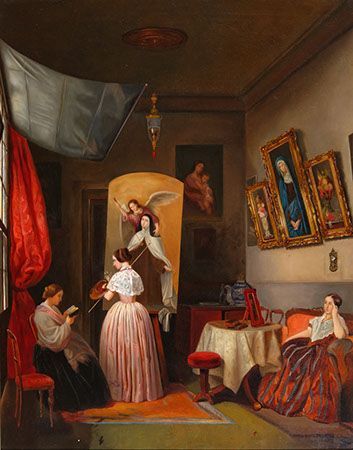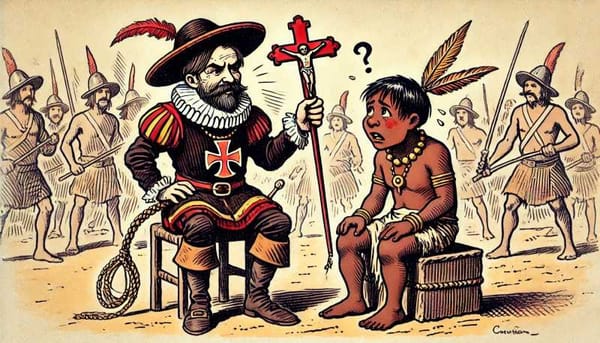The Sanromán sisters; forerunners of the painting by women in Mexico
Discover how, through their works, the Sanromán sisters questioned and overcame the traditional place relegated to women in the artistic field.

Through their works, the Sanromán sisters questioned and overcame the traditional place relegated to women in the artistic field (the muse, the object of inspiration, the ornament, and the domestic sphere).
History is not impartial; the great narratives that tell the story of humanity have a bias that is the result of the asymmetry of historical power between men and women. Therefore, it is not by chance that in the great narratives women are relegated to a secondary or complementary role since the dominant forms in which history is made possess a masculinist perspective in which men are synonymous with humanity, culture, and nation, or that in the best of cases women are reduced to "contributors" (never protagonists or bastions) in the construction of the nation and culture. As a Mexican art historian and curator Luis Vargas Santiago points out, making history is "the result of an exercise of power that highlights certain events, people and processes while hiding others, marginalizing them, erasing them.
In the history of art, some silences deny the existence and artistic production of women, with all the difficulties involved in having a woman perform tasks that were only considered to be proper to illustrious men. As researcher Anne Staples points out, women considered "enlightened" in the 19th century must have had the economic means to acquire a broad culture, because if you didn't have a fortune or a privileged situation it was impossible to access art and literature: "Among women, more than among men, having a fortune or belonging to a wealthy family was practically a requirement to enter the knowledge elite, and even then very few achieved it. Men, on the other hand, got opportunities that women did not even dream of.
According to Staples, several privileged women who lived in the transition period between the Viceroyalty and independent Mexico had the opportunity to cultivate themselves in the arts; however, these women, while shining for their talent and skills, stood out for "their ability not to offend male pride by competing in knowledge. Later in the 19th century, however, women had more opportunities to acquire new knowledge, develop their skills, and broaden the horizons of enlightened women.
This is the context in which the work of two women considered precursors of female painting in Mexico takes place; they are Josefa Sanromán and Juliana Sanromán, sisters who were part of a family originally from Santa María de los Lagos, today Lagos de Moreno, Jalisco, which migrated to Mexico City. The history of these painters has been collected in the research of Angélica Velázquez Guadarrama, master and doctor in History of Art at the UNAM and researcher at the Institute of Aesthetic Research, who explains that the historiography of art has been transformed by feminism and gender studies, making it possible for the work of these painters to be vindicated and analyzed outside the traditional discourses and standards of androcentric art history:
"Feminist art historians dedicated themselves to identifying and bringing to public attention artists who had been overlooked by traditional discourses that emphasized concepts such as genius, originality, and the consecration of masterpieces".
As Velázquez Guadarrama explains, Josefa and Juliana grew up in a family of seven brothers and sisters who were well off because their father, Blas Sanromán, was a merchant.
Although it is not known how the Sanromán sisters began to paint, the investigations of Leonor Cortina, and the analysis of the sisters' works, suggest that perhaps Pelegrín Clavé, a Catalan painter who arrived in Mexico to radically reform the teaching at the San Carlos Academy in the mid-19th century, was their private teacher since the portraits made by Josefa have similarities with the Catalan's work; Clavé also painted portraits of Juliana, Josefa and Refugio Sanromán that were exhibited around 1853, and the father of the painters had a constant presence at the San Carlos Academy in the 1850s.
The Sanromán sisters participated in the second exhibition held at the San Carlos Academy (it is believed that they also participated in the first one, however, there is no catalog to prove this); Josefa was part of this exhibition with three works while Josefina did the same with two. It should be noted that the collaboration of the San Román sisters in this exhibition, which showed their extensive preparation in painting, took place long before the women were able to enter the San Carlos Academy as students in 1888.
The painting was a predominantly male artistic expression, so the participation of women was marked by a clear differentiation, as the themes executed in the painting were determined based on gender, this made it possible for the work of women artists to be socially acceptable. That is why, according to art historian and teacher Dina Comisarenco Mirkin, women stood out mainly in the genre of still life, landscape, interior scenes, portraits, self-portraits, and copying of religious paintings by the great masters.
In that sense, it is important to stop at one of Josefa Sanromán's works, entitled Interior of an Artist's Studio, which was part of the San Carlos Academy's exhibition. In this work the painter makes a self-portrait with a scene of manners; however, the important thing about this piece is the allegory in the self-portrait, because according to Comisarenco it is a personification of the painting in which the author uses the home as a pretext to represent her view of women artists in an era when the demands for women's rights in education and equality were beginning.

In the interior of an artist's studio, Josefa portrays herself surrounded by elements and themes related to femininity and home life, as well as works of her own and her sister's authorship; however, what is interesting is that Sanromán represents herself as an artist since in the painting she appears holding a palette of colors and brushes, thus carrying out an iconographic operation that places her as a woman in action.
"Josefa represents herself and defines herself in her painting as an active creative subject, proud of her artistic creations, and accompanied by two other women, one of whom appears reading while the other reflects seriously. In this way, the artist highlights not only the superiority of painting as art, following what several artistic treatises of the time point out, but also the intellectual capacity of women in tune with the demands and changes of the time referred to above", says Dina Comisarenco Mirkin.
According to Velázquez Guadarrama, Interior of an Artist's Studio is one of the few representations in 19th-century Mexican art to show the artistic activity of a woman painter; the researcher even suggests that this work could be the first to represent a woman in this way.
Likewise, Juliana Sanromán is the author of a painting called Sala de Música, in which she depicts a young woman getting ready to sing while being accompanied by another woman who plays the piano, while a man on a sofa smokes and seems to enjoy the show. Again, this time in a play by Juliana, the woman takes an active role as a performer of the arts. However, at the same time that it seems that the representations of the Sanromán sisters contribute to broadening the horizon of the enlightened woman, Velázquez Guadarrama points out that the works of Josefa and Juliana contributed to reinforcing the bourgeois ideal of femininity of mid-century that was disseminated through various printed publications and that responded to the intention of raising the educational level of women.
However, this ideal was limited by the walls of home life and marriage, as women's education continued to be seen as a danger to their "natural" roles as mother and wife. It is at this point that the work of the Sanromán sisters acquires an extremely important value since their representations implied a transgression of the secondary and passive roles of women whose place is outside the arts and knowledge.
"If at first glance, and for today's viewer, the works of the Sanromán sisters seem to reproduce traditional values, when seen in the context of their time, they constitute a different image of Mexican femininity... In their paintings they conceived of themselves and examined themselves as actors and protagonists of their work, something quite unusual in the Mexican context," explains Velázquez Guadarrama.
Through their works and particularly their self-portraits, the Sanromán sisters questioned and overcame the traditional place relegated to women in the artistic sphere (the muse, the object of inspiration, the ornament, and the domestic sphere) while at the same time capturing on their canvases new possibilities for women by becoming, through their iconography, protagonists who are creators and capable of performing the arts with the same (or even more) skill and talent as men.
By David Olvera López, Source Secretariat of Culture




